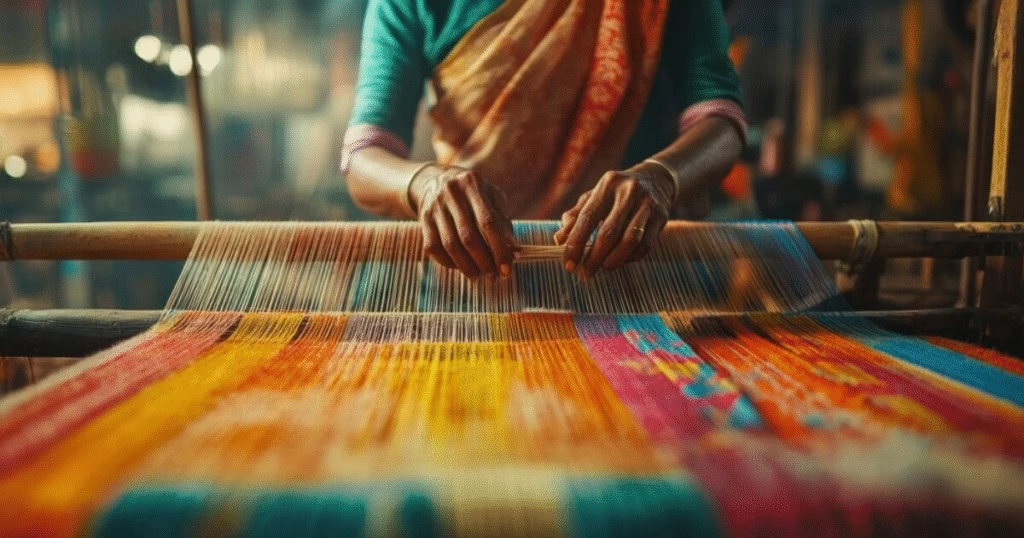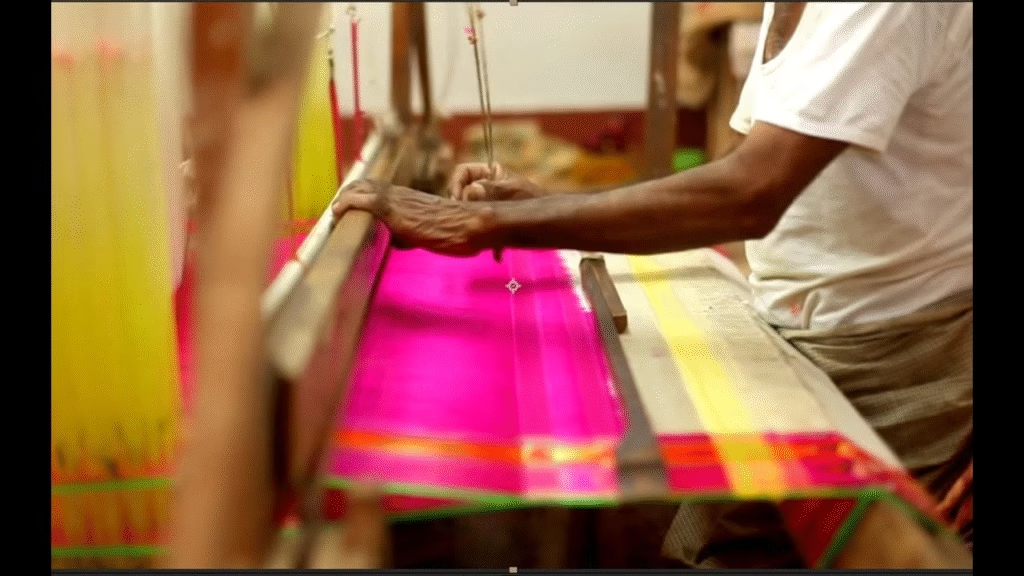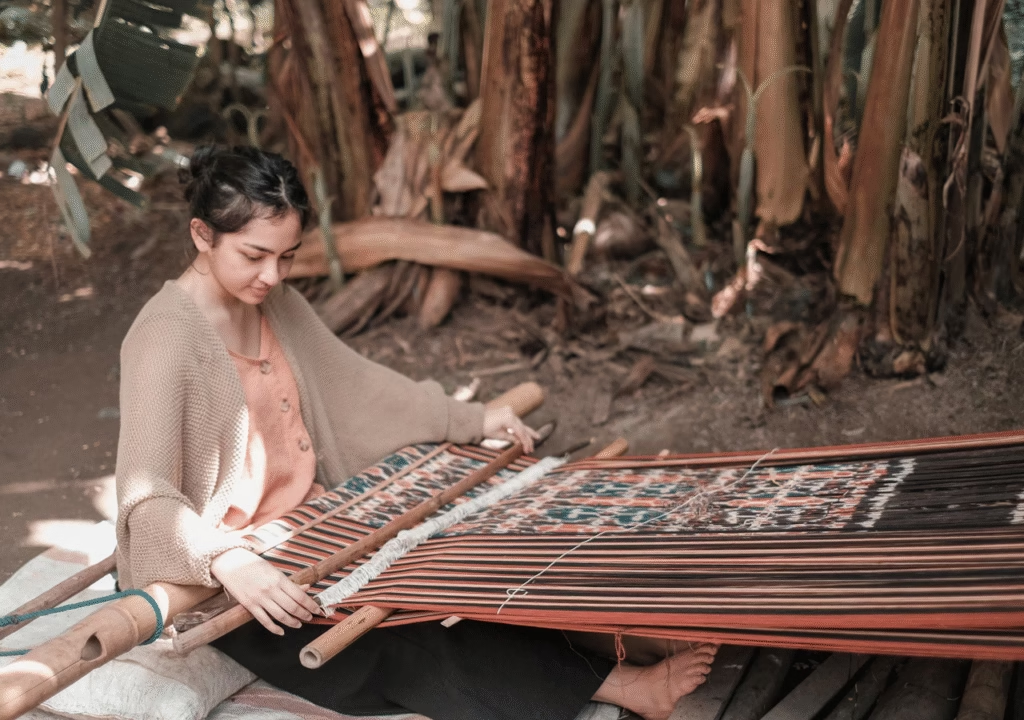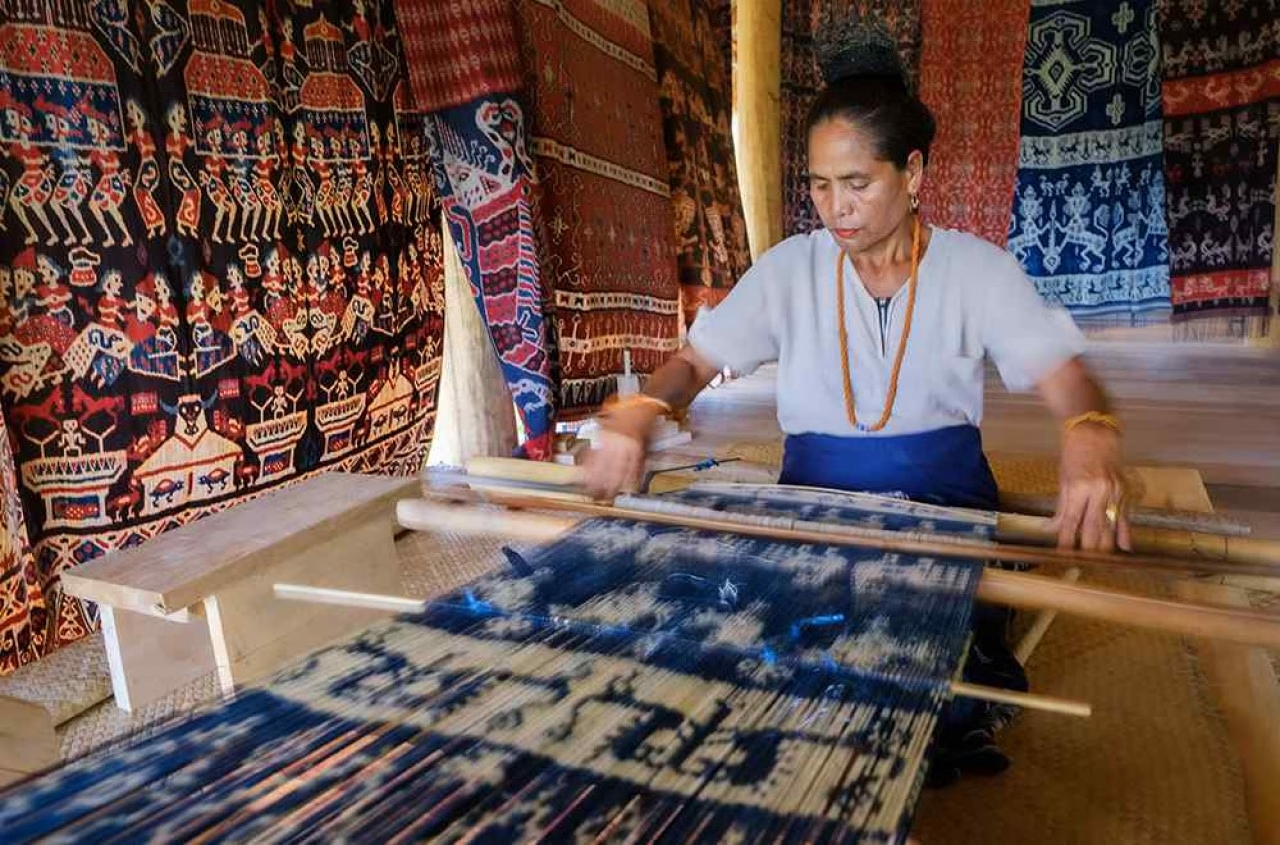Welcome to the fascinating world of Ikat Weaving, where every thread is dyed with a plan and every pattern feels like a work of magic. Unlike machine-made fabrics, this art form relies on sheer handloom precision, almost like painting with yarn before the weaving even begins. One slip of dye and, oops, you’ve got modern art instead of timeless tradition! That’s what makes Ikat so special. It’s not just weaving; it’s storytelling through threads.
But here’s the twist: Ikat is no longer limited to heritage wardrobes. From bustling markets in India to fashion-forward streets in New York, Ikat has slipped into global street style with surprising ease. In fact, with streetwear now valued at over $185 billion globally, designers are blending artisan techniques like Ikat to stand out in a sea of fast fashion. Practiced across more than 30 countries, this craft proves that tradition doesn’t have to be old-fashioned; it can be bold, edgy, and effortlessly cool.
What Makes Ikat Unique?

If you’ve ever looked at a piece of Ikat weaving and wondered, “How on earth did they do that?”; you’re not alone. The secret lies in a mind-boggling process where the threads are dyed before they’re woven. Imagine coloring a puzzle before you even put it together, and somehow expecting the picture to look perfect at the end. That’s the genius of Ikat. Unlike printed fabrics, where designs are stamped on after weaving, Ikat’s patterns are born in the very DNA of the cloth. It’s art, math, and patience all rolled into one.
This uniqueness is why Ikat has gone from quiet village looms to making a splash on global street style. Today, it’s spotted on jackets, sneakers, bags, and even luxury runways. Fun fact: handloom weaving in India alone supports nearly 4.3 million workers, and Ikat is a star contributor. It’s rare, it’s bold, and it carries centuries of tradition while looking surprisingly modern. No wonder designers love giving it a global twist!
From Village Looms
In its early days, Ikat weaving was all about community, culture, and storytelling. Villages passed down the craft for generations, each pattern carrying local meaning. What makes it so special?
- Threads are tied and dyed before weaving, super tricky but stunning.
- Each region has its own Ikat style, from India’s Pochampally to Indonesia’s double Ikat.
- Patterns are never exactly identical, which adds character.
- The process can take weeks or even months for a single piece.
It’s slow fashion in its truest sense, long before the hashtag trend.
To Global Runways
Fast forward to today, and Ikat weaving is strutting the streets of Paris, Milan, and New York. Big brands are mixing it into global street style because:
- Consumers crave authenticity in fashion.
- Streetwear is booming at $185 billion annually, making artisanship a hot trend.
- Ikat offers bold patterns that stand out in a fast-fashion crowd.
From cozy scarves to edgy sneakers, Ikat proves tradition can be timeless and trendy.
The Art of Ikat Weaving

Step into the world of Ikat weaving, and you’ll realize it’s not your average handloom story. Unlike other fabrics where the design comes after weaving, Ikat flips the script. Here, the threads are dyed before they’re woven, meaning the final look is partly planned, partly magic. Imagine baking a cake where you decorate the icing first and then hope it still looks good after baking, that’s Ikat for you. The result? Blurred yet beautiful patterns that are impossible to copy with machines.
That’s why Ikat has found its way from rural looms into global street style wardrobes, adding authenticity to jackets, sneakers, and even luxury dresses. With the global handloom industry valued at nearly $50 billion, Ikat stands tall as a textile that bridges heritage and high fashion. It’s proof that patience, skill, and a splash of creativity can create fabrics that outshine mass production. Tradition never looked this cool, or this stylish.
How Ikat Differs from Other Weaves
Ikat weaving is not like any ordinary weaving technique. It is a mix of creativity, patience, and skill that makes it shine in both traditional heritage and global street style. What makes Ikat so special is the way designs are created even before the fabric is woven.
Here are some simple points that show how Ikat weaving stands apart from other weaves:
- Designs are pre-dyed into yarns, not printed later.
- Patterns look slightly blurred, a trademark feature.
- Every Ikat piece is unique, no carbon copy possible.
- The process can take weeks, unlike machine-made fabrics done in hours.
These qualities make Ikat weaving more than just fabric; it becomes a story told through colors and threads. No two Ikat patterns are ever the same, and that is the real charm. It is slow fashion at its best, loved by people who want something authentic and stylish at the same time.
The Precision Behind Tie-Dye Threads
Ikat weaving is often compared to tie-dye, but the truth is, it’s tie-dye taken to a whole new level of precision. Imagine playing a game of chess where every move has to be carefully planned. That’s exactly how artisans treat each thread before it becomes part of a fabric loved in global street style.
Here’s how the process works step by step:
- Threads are tightly tied at specific points.
- They are dyed, then untied, and re-dyed multiple times.
- The placement of ties decides the final design.
- Even a small mistake can change the whole pattern.
This process is not quick, it’s slow, detailed, and feels almost like meditation for the weaver. But that is where the real beauty of Ikat weaving comes alive. The blurred yet precise designs give Ikat its signature charm, making every piece one-of-a-kind. This is why Ikat continues to shine in both heritage textiles and global street style fashion.
Regions Famous for Ikat Craftsmanship
Ikat weaving is not limited to one culture or country; it is a global art form. From Asia to Latin America, different regions have mastered their own style of Ikat, giving it a place in both heritage crafts and global street style. Each region adds its own twist, making the fabric even more colorful and diverse.
Some of the most famous regions known for their Ikat weaving are:
- India: Pochampally and Odisha Ikat, loved for their geometric and curvy designs.
- Indonesia: Double Ikat from Bali, one of the most complex techniques in the world.
- Uzbekistan: Bold and bright silk Ikats that stand out in fashion markets.
- Guatemala: Mayan-inspired Ikat designs with deep cultural meaning.
These regions prove that Ikat weaving is more than just fabric; it’s a living tradition. By blending old techniques with modern fashion, Ikat continues to stay stylish, timeless, and globally loved.
Cultural Roots and Symbolism

Behind every swish of fabric in Ikat weaving lies more than just dye and thread; it’s history, culture, and a whole lot of meaning. For centuries, Ikat has acted as a silent storyteller, wrapping people not only in cloth but also in identity and pride. Unlike machine prints churned out in minutes, Ikat takes time, patience, and heart. Villagers once wove patterns not for trends but for tales: symbols of fertility, prosperity, or spiritual protection. Wearing Ikat was like putting on your community’s diary, only more stylish.
Fast forward to today, and Ikat’s charm has leapt into global street style, where it’s no longer just about tradition but also about making bold fashion statements. Designers love its imperfections that scream authenticity in a world of fast-fashion clones. With handloom weaving supporting millions globally, Ikat’s cultural roots prove that fabric is more than what covers us, it’s what connects us across centuries and continents.
Ikat as a Storyteller of Traditions
Ikat weaving is more than just fabric; it is a language of patterns and colors. Every thread tells a story, and every design holds a meaning. Historically, Ikat was not only about style but also about identity, culture, and pride. Even today, its storytelling charm makes it popular in both traditional wear and global street style.
Here are some reasons why Ikat weaving is seen as a storyteller:
- Designs differ from tribe to tribe and region to region.
- Certain motifs represent fertility, good harvest, or spiritual strength.
- Weaving skills were often passed down through families for generations.
- Wearing Ikat once showed pride in community roots and social rank.
This is what makes Ikat weaving so timeless. It carries forward traditions while also fitting perfectly into modern fashion. Whether worn on the streets of a village or a city runway, Ikat keeps its storytelling power alive and strong.
Patterns and Their Meanings
Ikat weaving is not only about colors, it’s about hidden messages woven into every thread. The designs are more than decoration; they are symbols of beliefs, hopes, and traditions. This is why Ikat holds such a special place in both heritage fashion and global street style. Each pattern carries meaning, turning fabric into a storyteller of culture.
Here are some of the most common Ikat patterns and their meanings:
- Diamond shapes: Symbols of fertility and protection.
- Waves or zigzags: Represent life’s constant ups and downs, showing motion and energy.
- Floral motifs: Linked to prosperity, growth, and happiness.
Every cloth becomes like a poem that you can wear, a mix of beauty and meaning stitched together. That’s what makes Ikat weaving so unique. When you wear it, you don’t just wear fabric; you wear history, tradition, and art that still feel modern and stylish today.
Rituals, Festivals, and Everyday Wear

Ikat weaving has always been more than just fashion, it was part of daily life and special moments. In many cultures, Ikat carried blessings, joy, and identity. It wasn’t only about looking good but also about feeling connected to tradition. That’s why it still holds meaning today, whether in heritage dress or modern global street style.
Here’s how Ikat weaving was used in different ways:
- Worn during weddings and rituals as a symbol of blessings and good fortune.
- Used in festivals to spread joy and celebrate community togetherness.
- Made into everyday wraps and sarongs, bringing practical beauty to daily life.
Today, these same patterns travel beyond villages and ceremonies. Designers use Ikat in jackets, sneakers, bags, and accessories that fit perfectly into global street style. It shows how something deeply traditional can also look fresh and fashionable, making Ikat timeless across cultures and generations.
Ikat in Modern Fashion
The beauty of Ikat weaving is that it has aged like fine wine, getting bolder, cooler, and surprisingly versatile with time. Once confined to village ceremonies and heirloom wardrobes, it now struts confidently into city streets, high-end boutiques, and even luxury runways. What makes Ikat so perfect for modern fashion is its dual personality: rooted in tradition yet edgy enough for a pair of sneakers or a bomber jacket. It’s like your wise grandmother who also knows how to pull off a streetwear hoodie.
Globally, the fashion industry is worth over $1.7 trillion, and within that, streetwear alone is valued at nearly $185 billion. Designers hungry for authenticity are embracing Ikat’s imperfections as proof of craftsmanship in a world obsessed with mass production. Today, Ikat isn’t just “cultural clothing”, it’s the heartbeat of global street style, proving that threads dyed centuries ago still have the power to set trends on Instagram feeds and runways alike.
Ikat’s Entry into Contemporary Wardrobes
Ikat weaving has moved far beyond traditional looms and local markets. Today, it proudly walks the ramps, streets, and even everyday closets around the world. Its mix of heritage and fresh style has made it a global favorite. From cultural pride to fashion statements, Ikat has found its place in global street style with ease.
Here’s why people everywhere are falling in love with Ikat weaving:
- Perfect for casual tees, dresses, or jackets that blend comfort with culture.
- Traditional motifs meet edgy cuts, making every outfit stand out.
- Eco-conscious buyers admire its slow fashion appeal, since it takes time and effort to craft.
- No two Ikat pieces are the same, giving every wearer instant exclusivity.
This is why Ikat is more than just fabric, it’s personality stitched into your wardrobe. Whether styled for everyday wear or high fashion, Ikat weaving continues to shine as a timeless yet trendy choice.
Street Style Influencers Embracing Ikat
Open Instagram or TikTok, and you’ll notice a growing trend; street style influencers rocking Ikat weaving as confidently as denim. What was once seen mainly in traditional wear is now a bold part of global street style. The mix of heritage patterns with modern fashion makes Ikat a favorite for influencers who love to stand out.
Here are some ways influencers are styling Ikat weaving today:
- Bold Ikat jackets paired with sneakers for a casual yet chic vibe.
- Scarves and stoles that instantly upgrade simple outfits.
- Ikat bags and shoes turning into statement-making accessories.
The reason influencers love Ikat is simple: it’s different, eye-catching, and sustainable. In a world ruled by fast fashion, Ikat weaving gives them a way to express individuality while still supporting slow fashion. That’s why Ikat continues to shine on streets, screens, and runways as a global fashion statement.
Global Brands and Ikat Collaborations
Ikat weaving has traveled far from village looms to global fashion runways. Today, big brands and indie labels are teaming up with artisans to give this ancient craft a modern platform. These partnerships show how Ikat weaving can shine in both heritage fashion and global street style.
They also help keep the craft alive by blending tradition with commercial success.
Here are some ways brands are using Ikat in their collections:
- Limited-edition Ikat sneakers that mix comfort with culture.
- Runway-ready Ikat gowns showcasing heritage in high fashion.
- Everyday fashion lines with artisanal twists, making Ikat wearable for all.
These collaborations prove that Ikat weaving isn’t stuck in the past; it’s evolving for the future. By mixing artisanal skills with brand power, Ikat is reaching wider audiences and staying trendy. This bridge between craft and commerce ensures Ikat remains loved worldwide, both as tradition and as global street style fashion.
Handloom Craft Meets Sustainability
When you think of sustainable fashion, your mind might jump to bamboo straws, recycled sneakers, or second-hand jeans. But guess what? Ikat weaving has been eco-friendly long before hashtags like #SlowFashion existed. Unlike power looms that gulp electricity, handlooms sip energy gently; sometimes none at all. Natural dyes, local yarns, and zero-waste weaving make Ikat a star student in the sustainability class. If fast fashion is like junk food for your closet, then Ikat is the wholesome home-cooked meal you’ll never regret.
Here’s a fun fact: the handloom sector in India alone employs over 4.3 million people, making it the second-largest source of rural employment after agriculture. Add to that its low carbon footprint, and you see why designers worldwide are embracing Ikat. It’s not just about looking good; it’s about doing good. That’s why Ikat is making waves in global street style, where conscious choices meet edgy looks without costing the earth.
Why Handloom Ikat Is Eco-Friendly
In today’s world, fashion is not just about looking good; it’s also about caring for the planet. Handloom Ikat weaving naturally fits into this idea of slow, sustainable fashion. With its traditional methods and mindful use of resources, Ikat has become a favorite among eco-conscious buyers and trendsetters in global street style.
Here are some reasons why handloom Ikat is eco-friendly:
- Uses natural fibers and dyes, keeping fabrics safe for skin and the earth.
- No heavy machinery, which means a much lower carbon footprint.
- Zero-waste weaving, where every single thread is used with care.
- Locally sourced materials, reducing the impact of long-distance transport.
This makes Ikat weaving more than just a style choice, it’s a green choice too. It shows that fashion can be kind to the planet and still look fabulous. That’s why handloom Ikat is winning hearts in both sustainable wardrobes and global street style.
Supporting Artisans Through Ethical Fashion
Every piece of Ikat weaving carries the hard work and creativity of skilled artisans. These weavers keep traditions alive while shaping the future of global street style. By choosing Ikat, you are not only buying fabric; you are also supporting lives, communities, and culture. Ethical fashion begins with valuing the people behind the craft.
Here’s how supporting Ikat weaving helps artisans:
- Fair wages for traditional skills, giving artisans the respect they deserve.
- Keeping centuries-old crafts alive, so they are not lost to fast fashion.
- Reducing rural unemployment, by creating steady work opportunities.
- Empowering women weavers, who form the backbone of many weaving communities.
This is why your Ikat jacket, stole, or bag is more than just trendy. It’s a source of income, pride, and dignity for families who depend on this craft. Supporting Ikat weaving means choosing fashion that values both people and the planet.
The Slow Fashion Movement and Ikat
The world of fashion is changing, and more people are choosing slow fashion over fast fashion. Slow fashion means clothes made with care, time, and meaning; and that’s exactly what Ikat weaving represents. It’s not rushed or mass-produced. Instead, it celebrates patience, skill, and individuality, making it a natural fit for global street style.
Here’s why Ikat weaving belongs in the slow fashion movement:
- Takes weeks or months to weave, unlike factory-made clothes finished in hours.
- Every piece is unique, with no two patterns ever exactly the same.
- Timeless designs last longer, making them better than short-lived fast fashion trends.
That’s why Ikat weaving is special; it blends tradition and trend into one sustainable package. Wearing Ikat is not just about style; it’s also about making a conscious choice. It shows the world that fashion can be both beautiful and kind, standing strong in global street style.
The Future of Ikat in Global Fashion
The journey of Ikat weaving isn’t slowing down; it’s gearing up for a stylish leap into the future. What was once a village loom secret is now a fashion darling spotted everywhere from New York runways to Tokyo thrift stores. The beauty of Ikat lies in its ability to stay authentic while adapting to trends. In a world where fast fashion dominates (a $106 billion industry in 2023 alone), Ikat offers something rare; sustainability, artistry, and a story behind every thread. Think of it as fashion’s antidote to boring mass production.
And let’s not forget the power of global street style. Ikat isn’t just haute couture; it’s on sneakers, bucket hats, and even laptop sleeves. With consumers increasingly valuing authenticity and eco-conscious fashion, Ikat is perfectly positioned to rise as both a cultural keepsake and a modern wardrobe staple. If the past is any guide, the future of Ikat looks bright, bold, and endlessly stylish.
Preserving Craftsmanship in the Digital Age
In today’s digital world, old crafts and new technology don’t need to fight; they can grow together. Ikat weaving proves this beautifully. What began on handlooms centuries ago is now shining on screens, runways, and in global street style. Technology is helping artisans keep traditions alive while reaching wider audiences than ever before.
Here’s how the digital age supports Ikat weaving:
- Online platforms connect artisans to global buyers, opening new markets.
- Digital archives preserve ancient patterns, so future generations can learn from them.
- E-commerce allows small weavers to sell worldwide, without middlemen.
- Fashion tech merges heritage with modern design, keeping Ikat stylish and relevant.
The loom may be ancient, but its story continues in the digital era. By blending tradition with innovation, Ikat weaving proves that heritage can stay timeless while still adapting to the modern world of fashion and global street style.
Ikat as a Symbol of Cultural Fusion
Ikat weaving is like a fashion chameleon, it fits in anywhere. From villages to big cities, from heritage wardrobes to global street style, Ikat has shown how culture can travel and transform. What makes it special is its ability to blend tradition with modern fashion, proving that style has no borders.
Here are some examples of Ikat weaving as cultural fusion:
- Asian motifs reimagined in Western streetwear, giving old patterns a fresh twist.
- Traditional sarongs transformed into runway gowns, mixing comfort with luxury.
- Global designers pairing Ikat with denim and leather, creating bold fashion statements.
These examples show that Ikat weaving is not just about preserving the past; it’s about connecting cultures through design. It carries the soul of tradition while embracing the spirit of innovation. That’s why Ikat remains a global fashion favorite, uniting heritage and trend in one stylish package.
Will Ikat Become the Next Global Fashion Staple?
Ikat weaving has been around for centuries, but its popularity is growing faster than ever. With the rise of sustainable fashion and the global street style movement, Ikat is capturing the attention of designers, influencers, and everyday fashion lovers. Its blend of heritage, uniqueness, and trendiness makes it a strong contender for the next fashion staple worldwide.
Here are some reasons why Ikat weaving is gaining global attention:
- Rising demand for sustainable fabrics, as more people choose eco-friendly clothing.
- Streetwear market worth $185 billion is embracing artisanal textiles like Ikat.
- Celebrities and influencers flaunt Ikat in daily outfits, from jackets to accessories.
All signs point to a bright future. Ikat weaving combines tradition with trend, giving global street style a fresh yet timeless edge. Its unique patterns, slow fashion appeal, and cultural richness make it more than just fabric, it’s a fashion movement in itself.
Final Takeaway
Ikat weaving is more than just a fabric; it’s a story, a tradition, and a style statement all rolled into one. From village looms to global street style, Ikat has proven that heritage crafts can stay relevant, bold, and trendy. Its slow fashion process, unique patterns, and eco-friendly approach make it a favorite for conscious consumers and fashion enthusiasts alike.
Supporting Ikat weaving also means supporting skilled artisans, empowering communities, and preserving centuries-old techniques. Each piece carries culture, craftsmanship, and creativity, turning everyday wear into something meaningful. Global brands, influencers, and fashion lovers are embracing Ikat, blending traditional designs with modern streetwear, scarves, jackets, sneakers, and accessories.
With rising demand for sustainable and authentic fashion, Ikat is set to become a wardrobe staple worldwide. Whether you’re wearing it for style, culture, or conscience, Ikat weaving brings heritage into the modern world, making global street style more colorful, meaningful, and timeless than ever.
Visit our Traditional Art Blog to read them all in a simple, fun way.


Leave a Reply